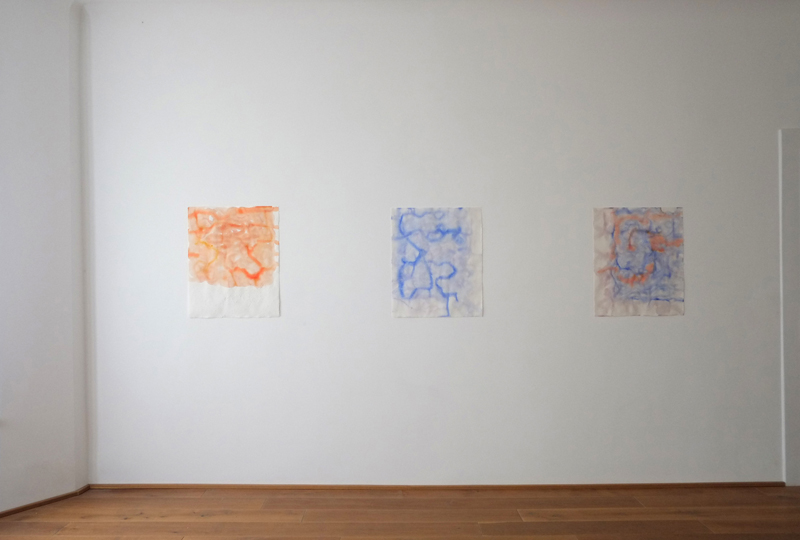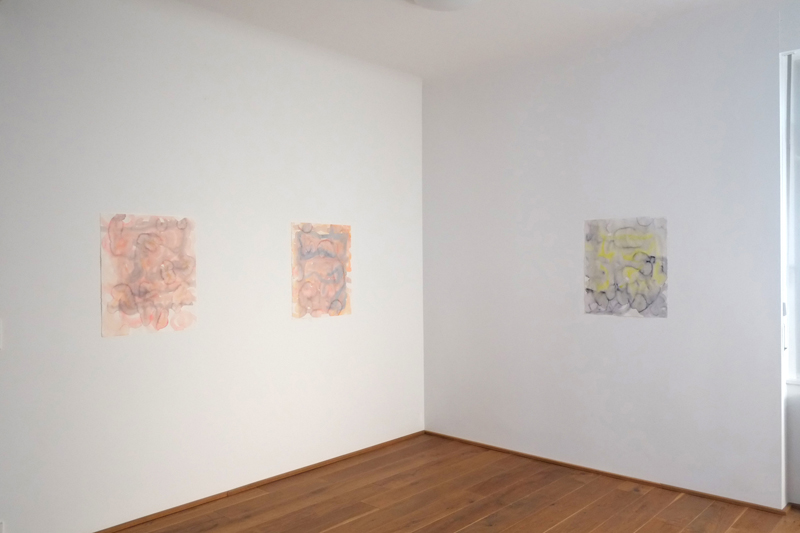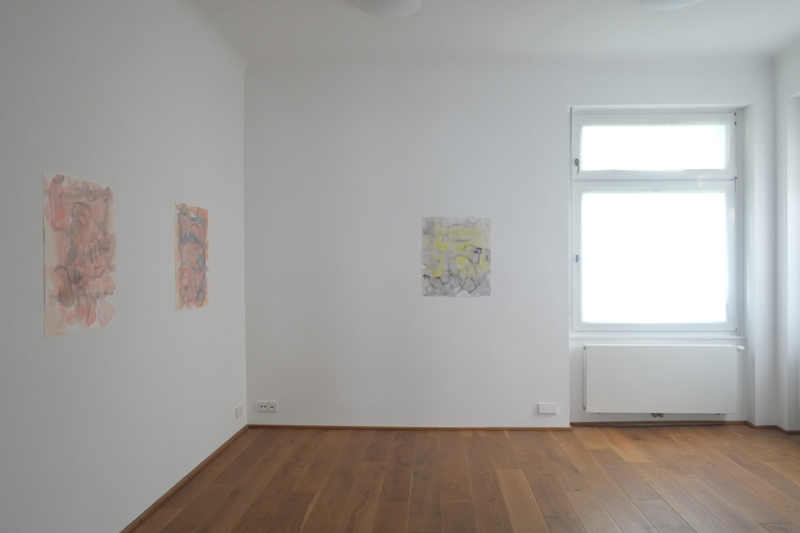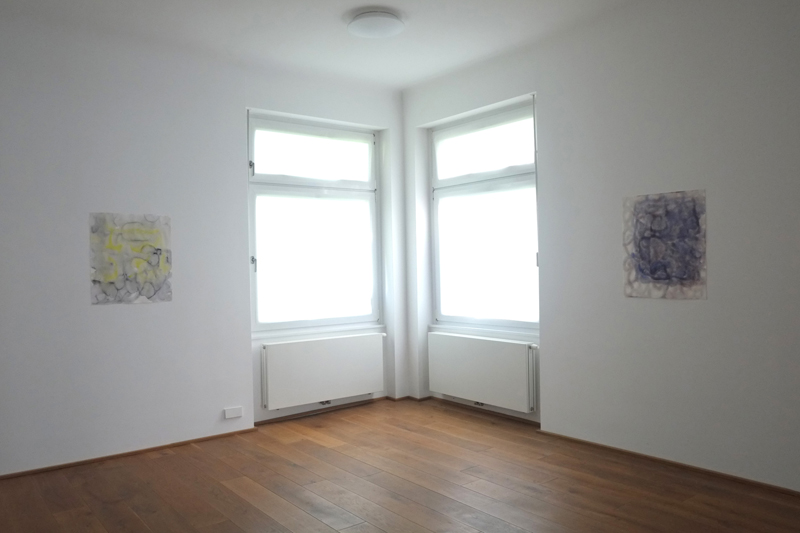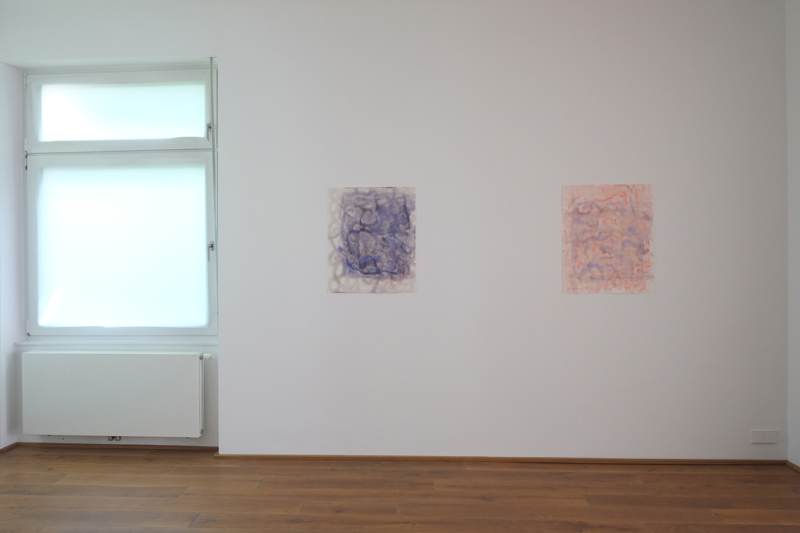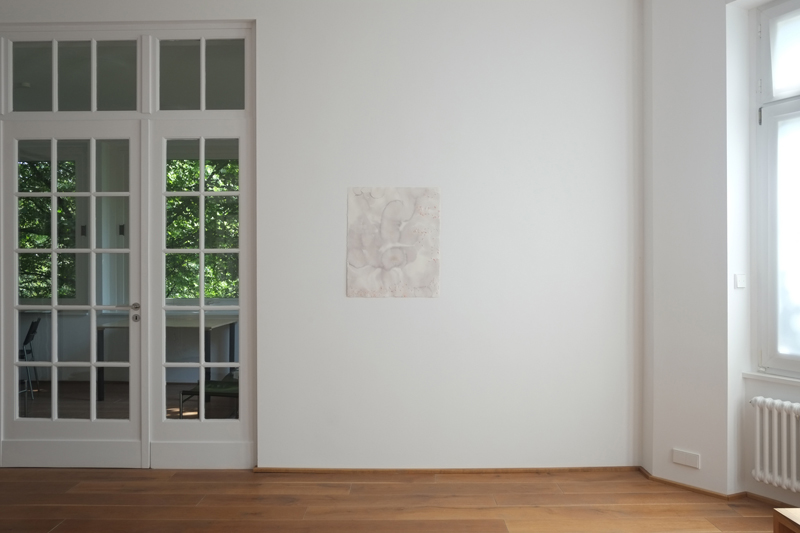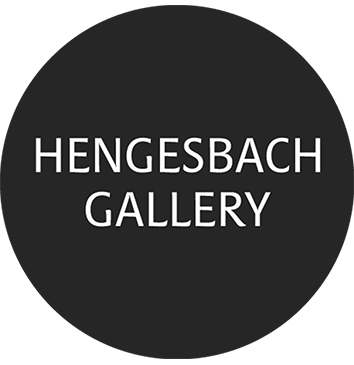Ulrich Wellmann
August 24 – September 25, 2015
The artistic work of Ulrich Wellmann is associated with radical painting, a movement that emerged in the late 1970s simultaneously in New York and Germany. At the forefront is the painting itself with its basic elements: image support, painting material, and painting gesture. These are placed into a strictly controlled and reflected relationship with each other. For most radical painters, the differing expressive power of color and the painting process are at the center of their investigation.
Since the early 1980s, Wellmann has continuously developed his work. In the first decades, he focused on the dialogical relationship between two colors—one forming the image background, while the other entered it with a few free accentuations of a short brushstroke. Wellmann emphasized the point of contact between the two colors in their material progression and tonal qualities. In recent years, this relationship has become increasingly open. The release of the painting gesture plays a larger role, and the fixed image background increasingly dissolves, so that both the painting gesture and the background enter into a relationship with the wall and surrounding space that is detached from conventions.
The medium that leads this process of detachment in Wellmann’s work is watercolor, which naturally exposes the material consistency of its support—or rather, brings it to the fore. Paper is created through the pulping and pressing of fibers in a watery slurry. Through strong soaking, the paper can be returned to its initial state. In addition, the colored pigment also exposes the fiber structure of the paper by penetrating its surface. The free painting gesture on the surface of the paper and the different concentrations of applied pigment can then be positioned in such a way that they enter into dialogue with the structure of the paper. Ideally, a condition can be achieved where the painted field appears to generate its own painting. No external forms are imposed on the paper—they unfold within the entanglements of its material consistency.
Ulrich Wellmann has followed this path for several years. To attune himself to the material consistency of the paper support, he prepares it beforehand by cutting into its surface with metal tools or working its edges, thereby appropriating the paper surface. In the next step, he wets the paper from both sides. Then he selects two or three tones. Here, both his emotional mood and the external mood of daylight play a crucial role. The chosen tones are meant to establish a tension, which will then find its expression and more precise articulation through the painting gestures—without any predetermined formal program imposed from the outside. Instead, the colors are allowed to unfold the potential of their mutual tension in the painting process, without the act of forming fixing or restricting this relationship. Wellmann’s work is focused on the articulation of such individual color fates within a defined pictorial field.
In the case of our exhibition Nine Watercolors, Wellmann decided not to limit himself to a single fate, but instead to initiate a multipart work that, like a variation piece, begins with a basic structure to which answers must be found. The basic structure of the painting movement in this case is a vaguely defined surface fragment, a square slightly stretched into a rectangle. It does not have an exact geometric form, but can still be perceived as a floating rectangular surface piece relating to the rectangular image support. In the opening sheet of Nine Watercolors. Burning, Wellmann chose a vertical image format and pierced it numerous times from the back with a burin in the lower area and on the right side. The piercing of a surface, as known from Fontana, is on one hand a performative act, but in the result also a constructive act of form. Piercing a surface is also a painting movement. In Wellmann’s case, the holes cannot be combined into a decipherable form. In the upper part of the picture, a preserved area of surface remains. For this sheet, Wellmann chooses yellow, brown, and orange as the colors, the spared area is watercolored. With open painting movements, he interweaves the tones or lets them stand in contrast to one another. The brown sinks into the image ground and forms a cloudy base with color-saturated, transparent, and color-thin areas. The orange is preserved in purer form in only a few places and forms a network of finger-wide veins, mainly in the right and upper areas. The yellow remains only as a more delicate, shorter vein trace in the left area.
In the second sheet, Wellmann takes up the rectangular painting form again, but this time it does not emerge from a defined area because the entire sheet was wetted. Instead, the pigment seems to have withdrawn from the water into this piece of surface. In counterpoint to the earthy brown and veiny red—the bodily colors of the first sheet—stands blue here as the color of openness. It sets itself off from glimmers of violet that form the surface ground. The blue forms a highlighted network of open curved paths, creating the impression that a distinctive path shape from the first sheet repeats here, just rotated 90 degrees. In the next sheet, the painting structure shifts from the left to the right edge. Blue and violet from the second sheet reappear, with orange from the first sheet emerging in a few dense zones at the edge and toward the center. The freedom of the blue here is no longer condensed into individual paths but is undergoing watery dissolution.
In the next sheet, the colors become more diluted; there are only a few concentrations, the blue dissipates into a gray, and traces or paths have expanded into zones. The original painted structure is only vaguely recognizable; from it emerge color islands, sometimes cell-like organic forms that seem to define themselves with a jagged wall—as a result of standing water—and an internal core. These formations in particular clearly demonstrate how Wellmann is able to elicit painterly qualities from water through his handling of it.
The fifth sheet is more strongly infused with yellow-orange tones. Blue emerges in the upper part of the sheet in the form of a rectangular painted figure, which is divided in the middle and extends downward along the right edge. It marks the painting form, which seems to spread across almost the entire pictorial square.
In the next sheet, blue, orange, red, and brown have completely disappeared. Gray accumulates into blurred patches. Between these appear traces of an intense bright yellow, which outlines the reduced painting form in contours.
In the seventh sheet, the painting form condenses from a watery background into free oscillations. Although there are moving traces, they seem corroded from within and in a state of dissolution. Blue has returned. Although individual areas show high concentrations of pigment, the color is not constructive but rather darkly broken and disintegrating.
The eighth sheet is noticeably brightened. The colors red, orange, yellow, and brown have returned. While the previous sheet gave the impression of condensation, this one conveys dilution, as if the colors are about to wash away. Only at the edges of the sheet, in drying areas, does the pigment seem to gather once again before flowing off. Blue indicates the painting form.
In the final sheet, color has vanished, with only some residual gray forming gentle patches. The paper ground is more massive, which is evident in the damage on the lower and right edges. From these emerges a bit of reddish brown from the back. The structure is comparable to the initial sheet. Painting, color, and the looseness of the painted figures, however, are clearly distinct from it.
The painting form is a surface piece that detaches itself from the pictorial field through a higher concentration of painting movements. It is not a form in the classical sense, not clearly defined, and not of a uniform internal structure. Sometimes it is barely distinguishable from the entire sheet. Nevertheless, it repeatedly separates itself from it. In this, it is comparable to the self in its world. The painting form is not a consistent thing or being. It is often recognizable only by its outer contour, not by an internal cohesion.
Doesn’t our human identity also initially consist only of our outer contour, with very changeable inner processes concerning our thoughts, feelings, physical condition, circulation, and digestion? And how much can we separate ourselves from our social and natural environment? Aren’t we constantly engaged in a tension between merging with our surroundings and distancing ourselves from them?
Ulrich Wellmann titled the work “Verbrennen” after its completion. There are no clues pointing to an illustrative interpretation. “Verbrennen” (to burn) can be read intransitively (to burn oneself) or transitively (to burn something). Our life is a process of maturation and dying. In this metabolism, we consume ourselves, use things up, transform them. The individual works repeatedly display concentrations, traces, movements, accumulations, mixtures as well as dissolutions and decay.
These processes do not have to be interpreted solely on an individual level in the sense of giving form to oneself, preserving and losing it. They can also point to our cultural situation, to societal inclusion or exclusion. And they may likewise be read in relation to German culture and its past.
Installation Views
